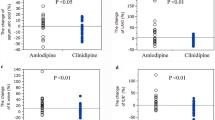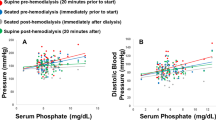Abstract
Objective: To study the influence of age on renal and haemodynamic effects of the calcium antagonist felodipine.
Methods: Eight young (mean age 27 years) and eight elderly (mean age 75 years) healthy normotensive subjects were given felodipine intravenously for 120 min aiming at close to therapeutic plasma level concentration. Renal blood flow (RBF) and renal vascular resistance (RVR) was estimated from para-aminohippuric acid (PAH) clearance 51CrEDTA clearance was used to measure glomerular filtration rate (GFR) and used in the calculations of fractional excretion (FE) of electrolytes. Impedance cardiography was performed to assess stroke volume and for the calculation of cardiac output and ejection fraction.
Results: At the end of felodipine infusion, the concentration of felodipine was on average 10.0 nmol · l−1 in young and 12.0 nmol · l−1 in elderly subjects (NS). During felodipine infusion blood pressure (BP) decreased from 138/76 to 120/68 in elderly subjects. The BP in young subjects was 126/74 at basal and 125/70 after infusion of felodipine. The systemic and renal vascular resistance decreased to a similar extent in young and elderly subjects after felodipine infusion. Felodipine caused a decrease in systemic vascular resistance from 25.6 to 23.3 in elderly and from 23.8 to 21.8 in the young subjects. Mean values for RVR at baseline and during infusion of felodipine were significantly higher in the elderly (10.1–15.1) than in the young subjects (5.4–6.7). Felodipine reduced RVR by 10% in the young and by 12% in the elderly at the end of infusion. The young subjects had 31% higher GFR than the elderly subjects at the start of infusion. Felodipine infusion did not affect GFR. There were no effects on stroke volume and ejection fraction. An initial natriuretic effect was found after infusion of felodipine in the young subjects. The fractional excretion of all electrolytes tended to increase after both felodipine and placebo, more in the elderly than in the young subjects.
Conclusion: The effects of felodipine on central and renal haemodynamics previously observed in young and middle-aged subjects also seem to exist in the elderly. Volume expansion seems to increase the excretion of electrolytes more in elderly than in young people, and therefore the effect of felodipine on natriuresis is more evident in young subjects.
Similar content being viewed by others
Author information
Authors and Affiliations
Additional information
Received: 25 October 1997 / Accepted: 7 April 1998
Rights and permissions
About this article
Cite this article
Lernfelt, B., Landahl, S., Johansson, P. et al. Haemodynamic and renal effects of felodipine in young and elderly subjects. E J Clin Pharmacol 54, 595–601 (1998). https://doi.org/10.1007/s002280050520
Issue Date:
DOI: https://doi.org/10.1007/s002280050520




